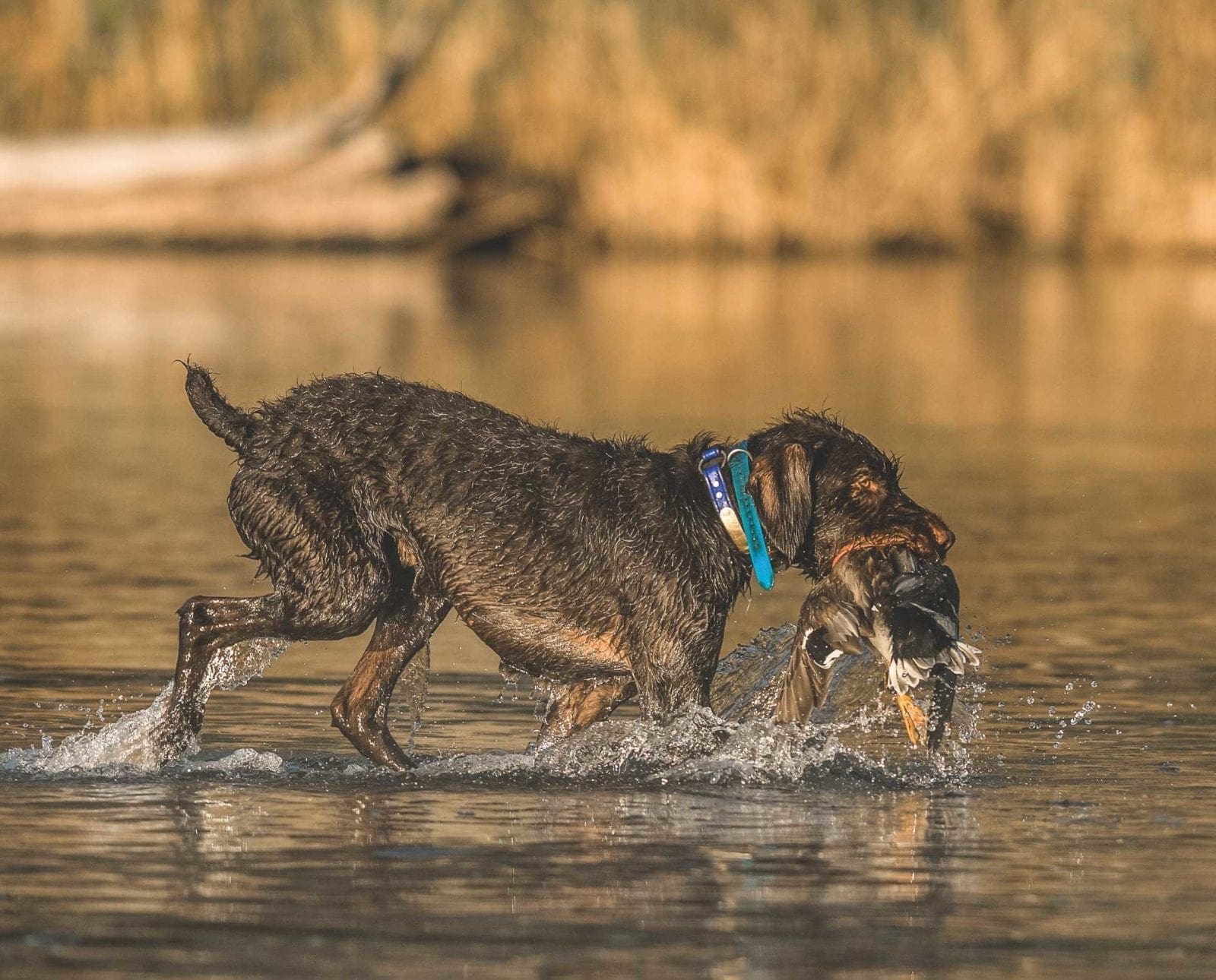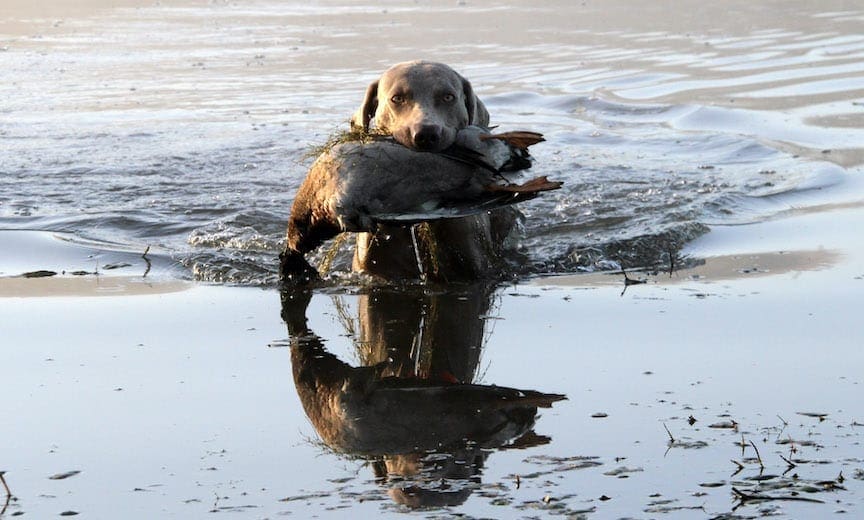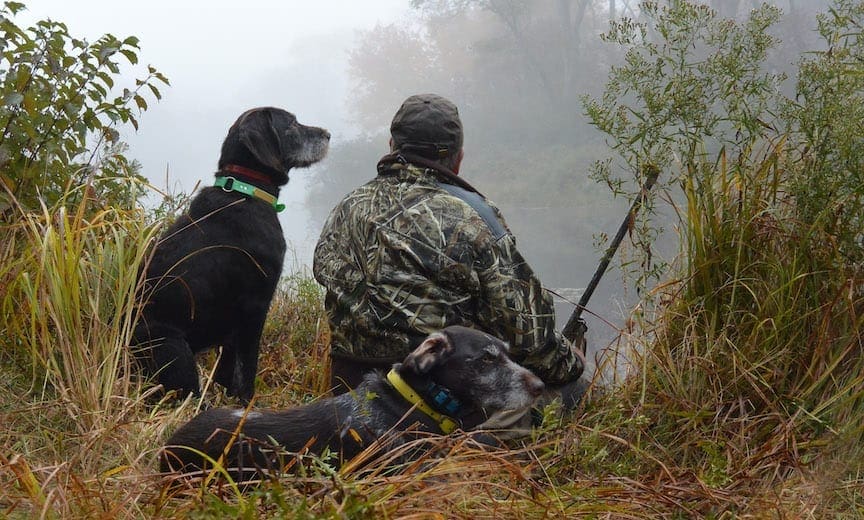Home » Hunting Dogs » Versatile Breeds as Waterfowl Dogs
Versatile Breeds as Waterfowl Dogs

Nancy Anisfield is an outdoor writer and hunting dog photographer,…
The value of versatile hunting dog breeds extends beyond the field and into the duck blind
The North American Versatile Hunting Dog Association (NAVHDA) defines “versatile hunting dog” as one that is bred and trained to dependably hunt and point game, and both track and retrieve on land or water. The versatile breeds were developed to give hunters one dog to use on a variety of game in a variety of environments, as opposed to having a kennel full of “specialty” dogs bred for one type of hunt or skill. Whereas many hunters expand breed purposes by hunting upland birds with retrievers or using their flushing dogs to retrieve ducks, the 30 pointing breeds recognized by NAVHDA are trained for land and water work intentionally and simultaneously.

German Wirehaired Pointers, German shorthaired pointers, pudelpointers, wirehaired pointing griffons and weimaraners are the most common versatile breeds found in the duck blind. That being said, plenty of Spinoni, braque breeds, Vizslas, Munsterlanders, Brittanys and other versatiles have proven their worth as dependable waterfowl retrievers. Given the versatile breeds’ broad range of physical and mental characteristics, two elements often surface that help determine whether or not they’ll be primo duck and goose dogs: their coats’ tolerance for water and cold, and their breeder’s emphasis on maintaining strong water drive in their lines.
Terry Wilson is a NAVHDA judge and avid waterfowl hunter. Over the years he’s had Labs and a Chesapeake Bay retriever, but has become a devoted German wirehair owner. When asked if he sees any advantage to waterfowl hunting with a versatile dog over a retriever breed, he says yes. “I believe the two very important things that separate the versatiles from the retrievers are the independent duck search and the ability to track wounded game on water,” Terry explains. “When hunting in a marsh environment, many times a duck drops in tall cattails after the mark and the dog is sent. For the most part, he is then on his own and must be able to search without commands or hand signals, tracking on water. Many times I have seen my wirehairs pick up the scent of a wounded duck on water and track it to shore, all done by nose. Many ducks have been retrieved that would otherwise have been lost if not for these traits.”
Al Watson, also an ardent waterfowler and German wirehair owner, agrees, pointing out that Labs, Chessies, and wirehairs are all sturdy water dogs with coats suitable for late season hunting and breaking ice. “The Lab is highly intelligent and trainable with laser focus and will do the task that is asked of them incredibly well,” Al says. “My personal preference is the GWP for the simple reason that the good ones have the prey drive, desire and remarkable ability to track and recover crippled birds with a ‘never quit’ mentality.”
Listen: Breaking Down the Versatile Hunting Dog Discussion with Phillip Mailey
Training and testing for water subjects in NAVHDA
The water skills covered in NAVHDA tests and training insist on waterfowl retrieving expertise equal to that of upland hunting ability. At the Natural Ability testing level, young dogs must demonstrate that they have the desire and confidence to swim, twice entering the water and swimming, whether they retrieve a bumper or not. On the subsequent testing levels—Utility Prep and NAVHDA Utility Test—the complexity of their water skills ramps way up. They must search a fairly large body of water containing substantial vegetation for a duck they have not seen drop, expanding their search, using their nose and water drive to look for it. They must understand that when the gun fires and they are released, it’s up to them to swim and scent the water without help from their handler. While swimming, they are judged on search, use of nose, desire to work, and stamina. The other test of a versatile’s water ability is to retrieve a tossed or launched duck through a set of decoys.
Similar to tests run for retrieving breeds, versatiles must be steady when guns are fired, remaining in position until they are sent into the water. Ducks caught during the search or at the marked retrieve must be delivered to hand with the dog waiting quietly for the handler to take it.
Many versatile dog owners agree that what these pointing dogs do on land reinforces their skill in the water. Jason Carter, a NAVHDA judge and professional trainer, understands the rewards of maximizing these dogs’ potential when it comes to waterfowl work. “Most of what we do for upland hunting translates in some fashion to the blind,” Jason explains. “Every problem has a set of drills to prep your dog. For example, one of the things I’m working on with my guys is remaining down if they notice the ducks last-second. Having a solid down is huge if hunting on ledges or open ground like we often do. When the ducks are distant, the dogs are more in point mode. When the ducks come in, if the dogs are surprised, they instinctively jump up and will flare close ducks. Getting the dogs to control their emotions is what I’m after.”

Training for complete versatility is worth the effort
Shaping a versatile hunting dog’s innate talents takes time, but the rewards of having a reliable, multi-talented gun dog are worth every minute. Years ago, when I questioned how much training I wanted to do with my first versatile dog and how far I would go to maximize his potential, Jason gave me an apt analogy to ponder. “You have a Ferrari. Why would you just drive it to the grocery store?” We were talking about what my shorthair would do as a grouse dog, but think waterfowling, substitute Donzi and the local frog pond, and you’ll get the picture.
Nancy Anisfield is an outdoor writer and hunting dog photographer, creative director for the Ugly Dog Hunting Company, member of the Pheasants Forever / Quail Forever Board of Directors, and co-owner of the Track2Wing Project which grants Action trackchairs to individuals with mobility challenges who want to train and hunt with bird dogs. She and her husband live in Hinesburg, Vermont, where their lives are governed by her two German shorthaired pointers and his two German wirehaired pointers.




The article is heavily loaded with European breeds and doesn’t mention Airedales. The Airedale originated in England but is as North American as a dog can get, and has, throughout its history, been known for its versatility, not just in hunting, but in the many ways that dogs work for us. One article I read recently refers to the Airedale as the “classic” bird dog.
Thank you for making the excellent point about Airedales being versatile in their skills. There are many fine breeds that are “versatile” in the sense of the word being used as a general adjective. My focus in the article was on the dogs recognized by NAVHDA as versatile in that they hunt, scent, point, track, and retrieve on land and water, with pointing ability being a defining part of their skill set and an element not always found in waterfowl dogs.